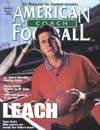AMERICAN FOOTBALL MONTHLY THE #1 RESOURCE FOR FOOTBALL COACHES
Article CategoriesAFM Magazine
|
FlashReleasing Five and Throwing Hotby: Rob Spence Co-Offensive Coordinator/QB Coach, Louisiana Tech © More from this issue In an effort to create a fully dimensional offense it is the opinion of this author that protections must be changed constantly to create defensive dilemmas. The ability to "free release" the running back in a one-back offense is critical to create a burden on the defense. It is essential that the running back be perceived as a viable receiving threat. This can only be accomplished through a protection that allows for the running back to release without regard to protection and a pattern scheme that considers the running back vital. Five-Man Protection Concepts and How They Relate To The QB's Thought Process50-51 Scat Protection The QB's understanding of the protection scheme is a priority when considering your teaching progression. The process begins with the triggerman's realization that he only has five protect....The full article can only be seen by subscribers.
|
|
|||||||
| HOME |
MAGAZINE |
SUBSCRIBE | ONLINE COLUMNISTS | COACHING VIDEOS |
Copyright 2025, AmericanFootballMonthly.com
All Rights Reserved





